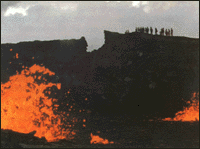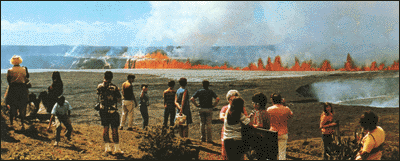Benefits of research at the Hawaiian Volcano Observatory
Hawaii is both a natural laboratory for the study of eruptive phenomena and a volcanic wonderland for visitors. The challenge facing scientists and government officials is clear: to reduce the adverse impact of eruptions in the short term, so that the residents and tourists in Hawaii can continue to enjoy the long-term benefits of volcanism. Toward this end, the Hawaiian Volcano Observatory (HVO) will continue to give timely warnings of anticipated volcanic activity, reliable and current progress reports on an eruption once it starts, and the best possible technical information on volcanic hazards posed by any eruption, present or future. In addition, the high eruption frequency of its volcanoes and the availability of state-of-the-art research facilities at HVO combine to make Hawaii an excellent training ground for volcanologists from around the world. HVO and other scientists are striving to improve volcano-monitoring and eruption-forecasting techniques, in order to reduce the risks associated with eruptions of active volcanoes in Hawaii and elsewhere.
Above: Visitors on the rim of Mauna Ulu crater, silhouetted against the dusky sky (upper right), observe an active lava lake sloshing a few tens of feet below them.
Below: Park visitors safely watch spectacular lava cascades and "curtains of fire" during the August 1971 eruption at Kilauea's summit. Photographs courtesy of the National Park Service.)

